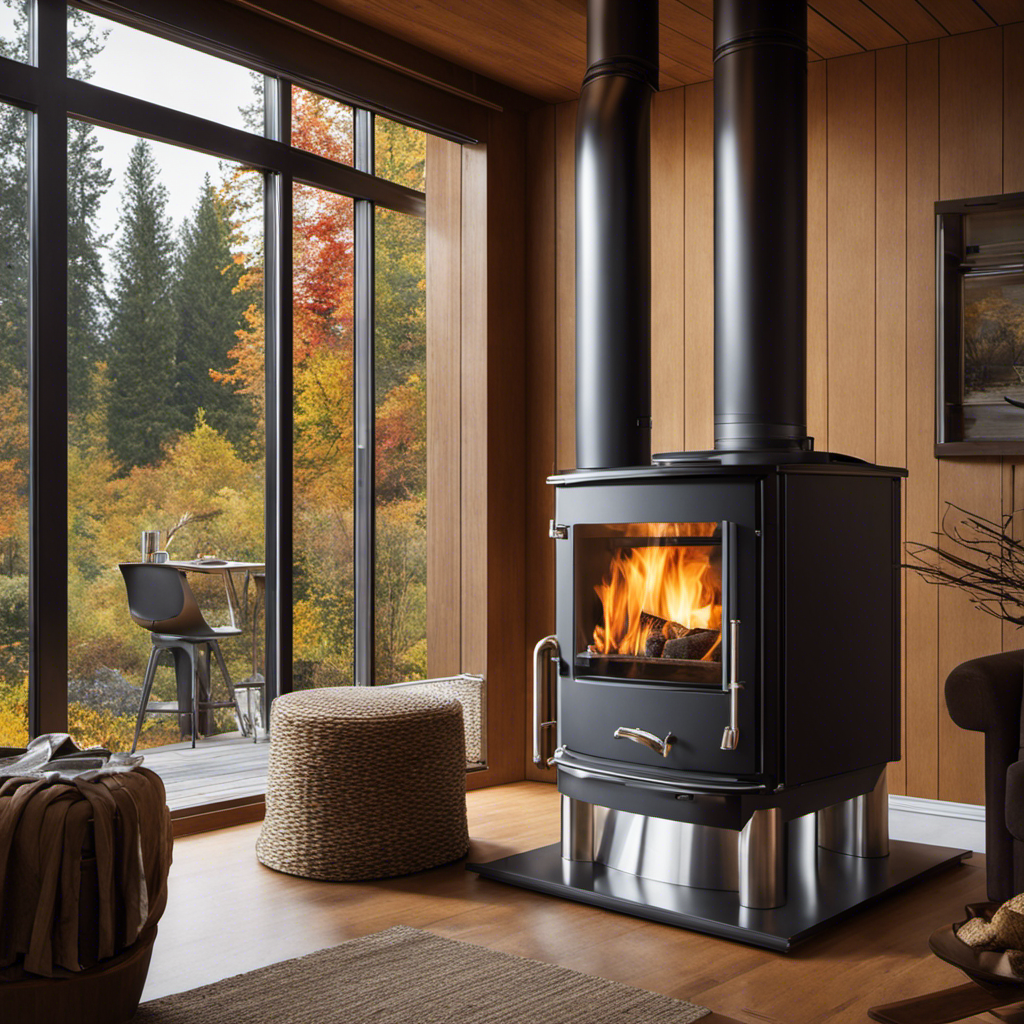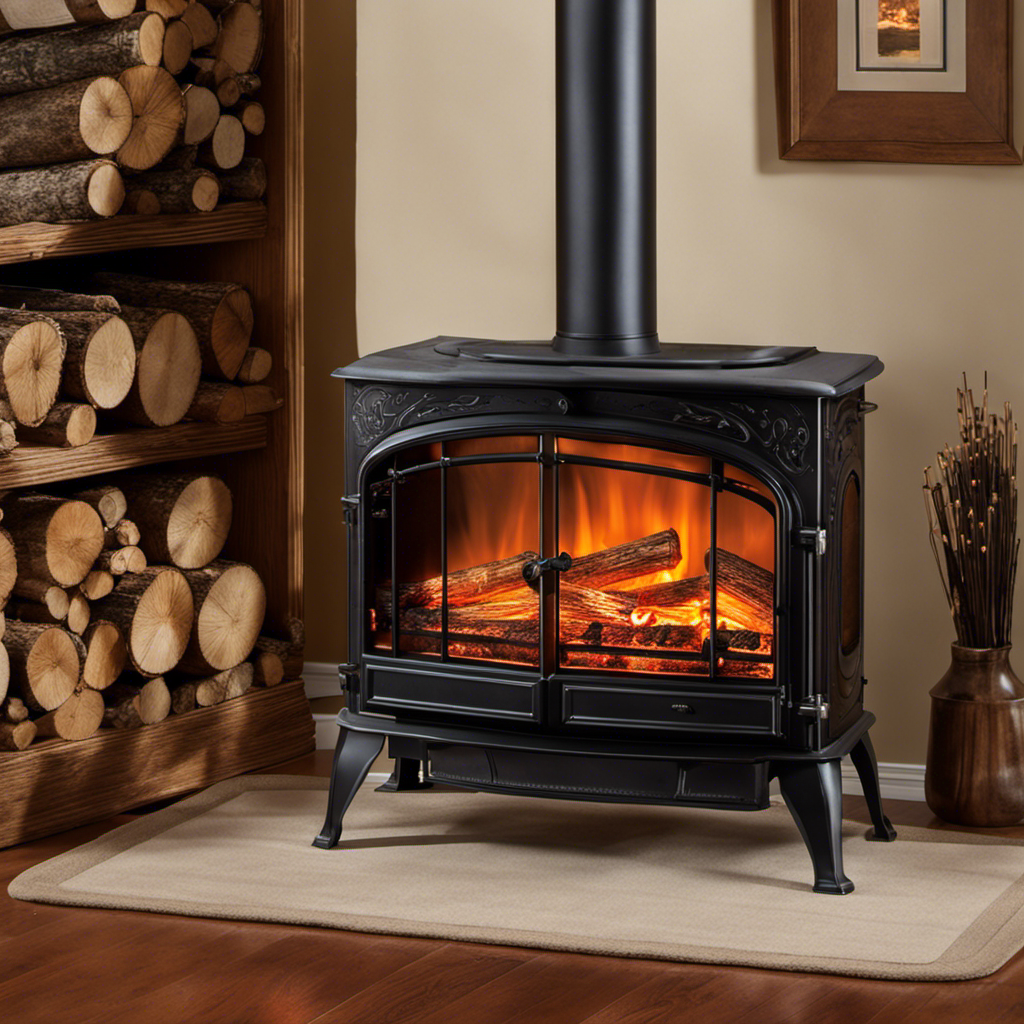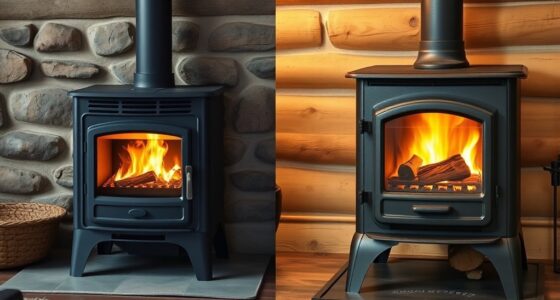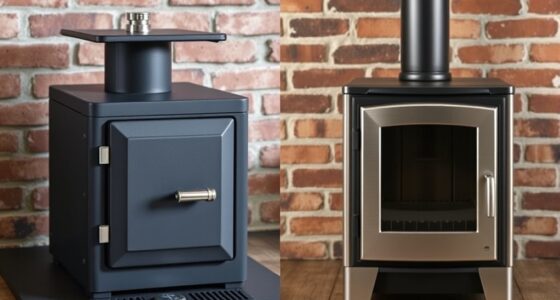As someone passionate about wood-burning stoves, my mission is to highlight the importance of selecting the proper stove pipes. It’s essential for maintaining both safety and operational effectiveness.
Today, we’ll delve into the world of stove pipes and discuss the factors to consider when making your selection. Single wall or double wall? Let’s explore the pros and cons of each.
Plus, we’ll touch on the importance of proper installation and maintenance for optimal performance.
Stay tuned for all the details!
Key Takeaways
- Stainless steel is a durable and corrosion-resistant option for stove pipes.
- Insulated stove pipes help retain heat, improve efficiency, and reduce condensation and chimney damage.
- Properly sized stove pipes with the correct clearance prevent hazards and efficiently carry smoke and gases out of the home.
- Regular maintenance and cleaning of the stove pipe are essential for preventing chimney fires and ensuring optimal performance and safety.
Different Types of Stove Pipes for Wood Stoves
I’m not sure which type of stove pipe to use for my wood stove. When it comes to stove pipes, there are a few common materials that are widely used. The most popular ones include stainless steel, galvanized steel, and black stove pipe.
Stainless steel is durable and resistant to corrosion, making it a great choice for long-term use. Galvanized steel is also durable and less expensive, but it may not last as long as stainless steel. Black stove pipe, on the other hand, is commonly used for connecting the stove to the chimney.
In terms of insulation, insulated stove pipes offer several benefits. They help to retain heat, which improves the overall efficiency of the wood stove. Insulated pipes also reduce the risk of condensation, preventing any potential damage to the chimney system. They provide better draft control, ensuring that the wood stove operates at its optimal level.
Additionally, insulated stove pipes help to minimize creosote buildup, reducing the risk of chimney fires. Overall, insulated stove pipes are a wise choice for anyone looking to maximize the performance and safety of their wood stove.
Factors to Consider When Choosing a Stove Pipe for Your Wood Stove
One important factor to consider when choosing a stove pipe for your wood stove is the diameter, as it determines the efficiency of the stove’s ventilation. The diameter of the stove pipe should match the size of the flue collar on your wood stove. A properly sized stove pipe ensures that the smoke and gases from the wood stove are efficiently carried out of your home, preventing any potential hazards.
Another factor to consider is the insulation of the stove pipe. Insulated stove pipes have several benefits. They help to increase the efficiency of your wood stove by reducing heat loss, resulting in more heat being directed towards your living space. Insulated stove pipes also minimize the risk of condensation forming inside the pipe, which can cause corrosion and damage over time. Additionally, they reduce the clearance requirements for combustible materials, allowing for a more flexible installation.
| Factors to Consider | Benefits of Insulated Stove Pipes |
|---|---|
| Diameter | Efficient ventilation |
| Insulation | Increased stove efficiency |
| Reduced risk of condensation | |
| Flexible installation |
Single Wall Vs. Double Wall Stove Pipes: Which Is Right for You
I frequently find myself debating between single wall and double wall stove pipes to determine which is the right option for my wood stove.
When it comes to choosing the right stove pipe, it’s essential to understand the pros and cons of each option.
Single wall stove pipes, as the name suggests, consist of a single layer of metal, making them cost-effective and easy to install. However, they’ve lower insulation properties and can be prone to heat transfer, increasing the risk of fires.
On the other hand, double wall stove pipes offer better insulation and reduce the risk of heat transfer. They’re more expensive and require professional installation.
Common mistakes to avoid when installing a stove pipe include improper clearance, inadequate sealing, and incorrect sizing.
Understanding the importance of proper stove pipe installation is crucial for ensuring the safe and efficient operation of your wood stove.
Understanding the Importance of Proper Stove Pipe Installation
Installing the stove pipe with the correct clearance and proper sealing is essential to prevent the risk of fires and ensure the safe operation of your wood stove.
Many people make common installation mistakes that can lead to dangerous situations. One of the most important aspects of stove pipe installation is maintaining the required clearance from combustible materials. This includes walls, ceilings, and other nearby objects. Failure to maintain the proper clearance can result in heat transfer and increased risk of fire.
Another crucial step is ensuring a tight seal between the stove pipe sections. Any gaps or leaks can allow smoke and gases to escape into your home, posing a health hazard.
Regular maintenance is also important to keep your stove pipe in good condition. This includes inspecting for any signs of damage or corrosion, cleaning out creosote buildup, and replacing worn-out parts.
Can I Use the Same Type of Stove Pipe for Different Types of Wood Stoves?
Yes, you can use the same type of stove pipe for different types of wood stoves. It is important to ensure that the materials for wood stove walls are appropriate for the specific type of stove you are using to ensure safe and efficient operation.
Maintaining and Cleaning Your Wood Stove’s Stove Pipe for Optimal Performance
Regularly cleaning and maintaining your wood stove’s stove pipe is crucial for optimal performance and safety. Here are some essential tips for cleaning and maintaining your wood stove pipe:
-
Remove creosote buildup: Creosote is a highly flammable substance that can accumulate in your stove pipe over time. Use a chimney brush to remove the creosote buildup regularly. This will help prevent chimney fires and improve the efficiency of your wood stove.
-
Check for obstructions: Inspect your stove pipe for any debris or obstructions that could restrict airflow. Remove any blockages to ensure proper ventilation and prevent smoke from entering your living space.
-
Inspect for damage: Regularly inspect your stove pipe for any signs of damage, such as cracks or rust. Replace any damaged sections promptly to maintain the integrity of your wood stove system.
Frequently Asked Questions
How Often Should the Stove Pipe Be Inspected for Any Damages or Leaks?
I inspect my stove pipe for damages or leaks at least once a year. It’s important to ensure proper insulation and regular cleaning to maintain the efficiency and safety of the wood stove.
Can a Stove Pipe Be Installed at an Angle or Does It Have to Be Strictly Vertical?
Installing a stove pipe at an angle is not recommended. It should be strictly vertical to ensure proper draft and prevent the accumulation of creosote. A vertical installation also allows for easier maintenance and cleaning.
Is It Necessary to Use a Chimney Cap With a Stove Pipe Installation?
It’s important to consider the necessity of a chimney cap during a stove pipe installation. Additionally, regular stove pipe inspections are crucial to ensure proper functioning and safety.
Are There Any Specific Regulations or Codes That Need to Be Followed When Installing a Stove Pipe for a Wood Stove?
When installing a stove pipe for a wood stove, it is important to follow specific codes and regulations. These installation requirements ensure proper ventilation and safety. Regular maintenance of the stove pipe is also necessary for optimal performance and longevity.
Can a Stove Pipe Be Extended or Should It Always Be the Exact Length Required for the Installation?
Yes, a stove pipe can be extended, but it should always be the exact length required for the installation. It is important to follow the length requirements to ensure proper ventilation and safety when using a wood stove.
Conclusion
In conclusion, when it comes to choosing the right stove pipe for your wood stove, it’s crucial to consider factors such as the type of fuel, stove size, and installation requirements.
Whether you opt for a single wall or double wall stove pipe, proper installation and regular maintenance are key to ensuring optimal performance and safety.
Remember, a well-maintained stove pipe will keep your wood stove roaring and radiant, ready to warm your home.
Logan’s affair with adventure began in childhood. He hailed from a small town where vast forests bordered one side and endless shores stretched on the other. His days were spent exploring uncharted woods, climbing tall trees, or listening to the tales of old sailors. This early immersion in a world brimming with stories and mysteries became the foundation of his passion for writing.











